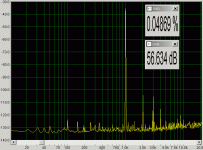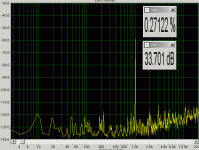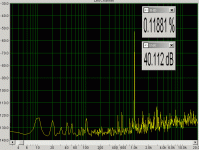All measurements are only one rail, as i can not lift my computers soundcard GDN from mains GND, and connected across both rails balanced, it gets bad ground loop noise effects. The only way i can do sme FFT and THD measurements is with the soundcard. As i said there is no groundplane and no optimized layout. The numbers may get better with more care for this. The voltage at the buffers source is about 13,40V for all four buffers. I did search for differences in voltages or currents to measure in both D1 stages, but did not find.
Would the ISO150 be right to isolate I2S from transport also?
Would the ISO150 be right to isolate I2S from transport also?
till said:All measurements are only one rail, as i can not lift my computers soundcard GDN from mains GND, and connected across both rails balanced, it gets bad ground loop noise effects. The only way i can do sme FFT and THD measurements is with the soundcard. As i said there is no groundplane and no optimized layout. The numbers may get better with more care for this. The voltage at the buffers source is about 13,40V for all four buffers. I did search for differences in voltages or currents to measure in both D1 stages, but did not find.
Would the ISO150 be right to isolate I2S from transport also?
The buffers are ok.
Is the distorted channel the same as the one with the inverters?
Just curiosity.
if your player and your dac has no connection to mains earth (that's quite common) you can connect the + to the RCA +, and the - to the RCA ring
I would think so, but in reality i get a lot of hum this way.
The buffers are ok.
Is the distorted channel the same as the one with the inverters?
Just curiosity.
As i wrote: the difference lays in the D1 stage. You can see at the picture i can use D1 stage #1 with DAC A or with DAC B like i want. There is not one inverted DAC, but one DAC carrys L+ & L- the other R+ and R-. The measurements are same with DAC changed, or with another DAC plugged into the socket. What tells about 0.05% of this THD may come from DAC, the one D1 stage adds very very little, the other adds about 0,2%. This 0,2% can not be caused by the DAC or by inverter! Also there can not be a big malfuction as this would cause serios THD and not 0,2%. The 2 D1 channels look absolutely equal. What could bve the souce of this THD? The connection for volume setting /gain is left open for full gain, but a resistor doesn´t really change it.
Please have a look at the very different harmonics signature for the both stages.
till said:As i wrote: the difference lays in the D1 stage. You can see at the picture i can use D1 stage #1 with DAC A or with DAC B like i want. There is not one inverted DAC, but one DAC carrys L+ & L- the other R+ and R-. .
I agree there is not an inverted dac , it is just that one channel (L?)has the DATA inverted at its input , and also WS is used "right" and "inverted "for differential opertion.Isn'it?
No ,no.It will perform better L-L+ and R-R+ at least from the S/N point of view.The essence comes down to a differential measurement at this point , and I know that it isn't an "everyday thing".
In my currently balanced 1543 L+R+ , L-R- plus D1 stage,the funny thing is that it is better from the "sound" point of view , even from the intrinsic DAC S/N one , but the balanced line picks up some noise from the drive otherwise absent in single ended mode.
While I fear that my Philips CD isn't a champion in terms of ground arrangements , probably the transformers in digital line may be the cure.
With the Sony (L+L-, R+R-) the noise picked up in single ended and not in balanced.
In my currently balanced 1543 L+R+ , L-R- plus D1 stage,the funny thing is that it is better from the "sound" point of view , even from the intrinsic DAC S/N one , but the balanced line picks up some noise from the drive otherwise absent in single ended mode.
While I fear that my Philips CD isn't a champion in terms of ground arrangements , probably the transformers in digital line may be the cure.
With the Sony (L+L-, R+R-) the noise picked up in single ended and not in balanced.
Yes, i know the SNR point, but what about all those timing and jitter hysteria, we need to manipulate teh latch signal for this setup, for the other we don´t need. I would suspect timing differences on latch will be much more significant than on the other lines.
As i wrote, the THD numbers gets better with the balanced measurement, but 50Hz and all harmonics of that happen. I will try to measure with lifted GND of soundcard or so.
Also this does not affect the big question, why one of the D1 stages performs that different than the other.
As i wrote, the THD numbers gets better with the balanced measurement, but 50Hz and all harmonics of that happen. I will try to measure with lifted GND of soundcard or so.
Also this does not affect the big question, why one of the D1 stages performs that different than the other.
Just to clarfy , I must admit that it was a bad cabling issue to creatin' that problems above; my pretence was to use 2 RCA cables instead of a XLR one ( experimentg setupsstefanobilliani said:In my currently balanced 1543 L+R+ , L-R- plus D1 stage,the funny thing is that it is better from the "sound" point of view , even from the intrinsic DAC S/N one , but the balanced line picks up some noise from the drive otherwise absent in single ended mode.
The results now are that the 1543 balanced has a very good S/N ratio , audible differences from the single ended version and NO MORE piked up noise from the drive .VERY silent.
Another thing that I like to report to is the fact that previously I was using the I2S signals from the CD player through a single multiwire USB cable, just yesterday I separated the signals into 4 shielded cables (for that matter it pays a lot apply the suggestions for the grounding/cabling described in the Passlabs article "ground loops" and use it also for the PS over that for all kinds of transmitted signals )and the sounds taked up a better perspective stage and CLEAR timing.
I believe this changes have let me revise my prejudices regarding the sinchronous reclocking.
BTW this is my experience
I would use buffers on all lines at this point , for example like I did with the XORs in my balanced project.till said:Yes, i know the SNR point, but what about all those timing and jitter hysteria, we need to manipulate teh latch signal for this setup, for the other we don´t need. I would suspect timing differences on latch will be much more significant than on the other lines.
But now I also begin to understand what means the use of single packages for logic functions .
I think I will report in the other thread all the currently set up in all its parts , since I believe that after tough work and persistance I achieved very good reproducted sound ,not affected by the every-day-market machines defeacts.
now what do you get if you measure the balanced signal?
if i measure with lifted ground i get only hum also. Not possible to measure the balanced signal properly. If i measure using a transformer i get much worse figures because the transformers i have a not good enough for this i suspect.
and are your PS lines still polluted?
show me any power supply line not "polluted" .
I tried less impedance PS, other decoupling, the transformer in spdif, and it all does not much measureable differences with my measurement equipment. Before i see any real point in this, more than akademic discussion, i need to see compareable measuremets of other basic approaches. I wonder why there are so many "best sounding" DACs on the net, but only a few comparable measurements like for example pedjas http://users.verat.net/~pedjarogic/audio/
for comparison measurement with transfomer SE
Attachments
there is no ground to earth , not on the DAC nor on the transport. The computer does add too much mess if i lift its ground. Also my SNR goes down 20dB when i turn on the satellite reciver card 2 slots next to the soundcard. When measuing anything with the soundcard that has any connection to some earth ground i will get enough ground loop to see it on the FFT. There is no way to measure a balanced signal with good quality with SE input, unless someone writes some software to use both stereochannels as one balanced input.
till said:more than akademic discussion, i need to see compareable measuremets of other basic approaches. I wonder why there are so many "best sounding" DACs on the net, but only a few comparable measurements
Unfortunately I can't add too much with numbers since measurements instruments aren't in my posses , but I wouldn't be surprised if someday you will replace the clock and/or use a decent recloker and see distorsion decrease dramatically in the set-up. Of course , if your instruments are able to see it
- Status
- This old topic is closed. If you want to reopen this topic, contact a moderator using the "Report Post" button.
- Home
- Source & Line
- Digital Source
- DAC alive


